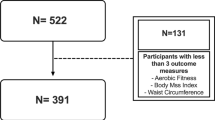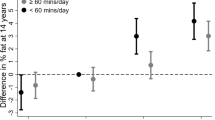Abstract
Background/Objectives:
Physical activity and exploration in infancy affect physical and cognitive development. Nutritional supplementation improves activity in severely malnourished infants, but the evidence in mild-to-moderately malnourished and nutritionally at-risk infants is equivocal. We tested the effect of multiple-micronutrient supplementation on physical activity and exploration in Mexican infants.
Subjects/Methods:
Using a quasi experimental design, we analyzed data from a supplementation study that lacked a placebo-control group. We compared infants between 8 and 12 months measured at baseline who had received no supplementation (comparison group, n=78), with infants 8–12 months measured after 4 months of daily supplementation (treatment group, n=109). The treatment consisted of three supplement types: micronutrient powder, syrup (each containing only micronutrients) and a milk-based, fortified-food supplement (FFS; containing micronutrients and macronutrients). We formed the micronutrient-only group (MM) by combining the micronutrient powder and syrup groups. We measured activity and exploration by direct observation and used cluster analysis to form and characterize activity and exploration clusters. We performed logistic regression with activity or exploration cluster as the outcome variable and treatment versus comparison and MM or FFS versus comparison as the predictor variables.
Results:
Treatment versus comparison increased the odds of being in the high activity (odds ratio (OR)=2.35, P<0.05) and high exploration (OR=1.87, P<0.05) cluster. MM increased the odds of being in the high activity (OR=2.64, P<0.05) cluster and FFS increased the odds (OR=3.16, P<0.05) of being in the high exploration cluster.
Conclusions:
Nutritional supplementation benefited activity and exploration in this sample of Mexican infants.
This is a preview of subscription content, access via your institution
Access options
Subscribe to this journal
Receive 12 print issues and online access
$259.00 per year
only $21.58 per issue
Buy this article
- Purchase on Springer Link
- Instant access to full article PDF
Prices may be subject to local taxes which are calculated during checkout

Similar content being viewed by others
References
Aburto NJ, Ramirez-Zea M, Neufeld LM, Flores R (2009). Some indicators of nutritional status are associated with activity and exploration in infants at risk for vitamin and mineral deficiencies. J Nutr 139, 1751–1757.
Angulo-Kinzler RM, Peirano P, Lin E, Algarin C, Garrido M, Lozoff B (2002a). Twenty-four hour motor activity in human infants with and without iron deficiency anemia. Early Hum Dev 70, 85–101.
Angulo-Kinzler RM, Peirano P, Lin E, Garrido M, Lozoff B (2002b). Spontaneous motor activity in human infants with iron-deficiency anemia. Early Hum Dev 66, 67–79.
Belsky J, Goode MK, Most RK (1980). Maternal stimulation and infant exploratory competence: cross-sectional, correlational, and experimental analysis. Child Dev 51, 1163–1178.
Belsky J, Most RK (1981). From exploration to play: a cross-sectional study of infant free play behavior. Dev Psych 17, 630–639.
Bentley ME, Caulfield LE, Ram M, Santizo MC, Hurtado E, Rivera JA et al. (1997). Zinc supplementation affects the activity patterns of rural Guatemalan infants. J Nutr 127, 1333–1338.
Black MM, Caqui AH, Zaman K, Persson LA, El Arifeen S, Le K et al. (2004). Iron and zinc supplementation promote motor development and exploratory behavior among Bangladeshi infants. Am J Clin Nutr 80, 90–91.
Chávez A, Martínez C (1975). Nutrition and development of children from poor rural areas. V. Nutrition and behavioral development. Nutr Rep Inter 11, 477–489.
CONAPO: Consejo Nacional de Población (2000). Indice de marginación a nivel localidad. Mexico, D.F. [CONAPO: National Population Council. Marginalization Index and the local level.] span. [cited 2005 Oct 6]. Available from: http://www.conapo.gob.mx/index.php?option=com_content&view=article&id=143&Itemid=207.
Edgerton VR, Gardner GW, Ohira Y, Gunawardena KA, Senewiratne B (1979). Iron-deficiency anaemia and its effect on worker productivity and activity patterns. Br Med J 2, 1546–1549.
García-Guerra A, Rivera-Dommarco J, Neufeld LM, Domínguez-Islas CP (2009). Effect of three supplements with equal micronutrient content on serum zinc concentrations in Mexican children. FASEB J 23, 917.13.
Golub MS, Keen CL, Gershwin ME (1985). Studies of marginal zinc deprivation in rhesus monkeys: infant behaviour. Am J Clin Nutr 42, 1229–1239.
Golub MS, Keen CL, Gershwin ME (2000). Moderate zinc-iron deprivation influences behavior but not growth in adolescent rhesus monkeys. J Nutr 130, S354–S357.
Golub MS, Takeuchi PT, Keen CL, Hendrick AG, Gershwin ME (1996). Activity and attention in zinc-deprived adolescent monkeys. Am J Clin Nutr 64, 908–915.
Grantham-McGregor S, Stewart M, Powell C (1991). Behavior of severely malnourished children in a Jamaican hospital. Dev Med Child Neurol 33, 706–714.
Graves PL (1976). Nutrition, infant behaviour, and maternal characteristics: a pilot study in West Bengal, India. Am J Clin Nutr 29, 305–319.
Graves PL (1978). Nutrition and infant behavior: a replication study in the Kathmandu Valley, Nepal. Am J Clin Nutr 31, 541–551.
Harahap H, Jahari AB, Husaini MA, Saco-Pollitt C, Pollitt E (2000). Effects of an energy and micronutrient supplement on iron deficiency anemia, physical activity and motor and mental development in undernourished children in Indonesia. Eur J Clin Nutr 54, S114–S119.
Hernandez-Prado B, Hernández-Ávila M eds (2005). Evaluación externa de impacto del Programa Oportunidades 2004. Alimentación. Primera ed. [External Evaluation of the Impact of the Oportunidades Program 2004, 1st edn]. Instituto Nacional de Salud Pública: Cuernavaca, Mexico.
Hesse GW, Hesse KA, Catalanotto FA (1979). Behavioral characteristics of rats experiencing chronic zinc deficiency. Physiol Behav 22, 211–215.
Hunt JR, Zito CA, Erjavec J, Johnson LK (1994). Severe or marginal iron deficiency affects spontaneous physical activity in rats. Am J Clin Nutr 59, 413–418.
Jahari AB, Saco-Pollitt C, Husaini MA, Pollitt E (2000). Effects of an energy and micronutrient supplement on motor development and motor activity in undernourished children in Indonesia. Eur J Clin Nutr 54, S60–S68.
Lawrence M, Lawrence F, Durnin JV, Whitehead RG (1991). A comparison of physical activity in Gambian and UK children aged 6–18 months. Eur J Clin Nutr 45, 243–252.
Levitsky DA, Barnes RH (1972). Nutritional and environmental interactions in the behavioral development of the rat: long-term effects. Science 176, 68–71.
Lewis MD (2000). The promise of dynamic systems approaches for an integrated account of human development. Child Dev 71, 36–43.
Li R, Chen X, Yan H, Deurenberg P, Garby L, Hautvast JG (1994). Functional consequences of iron supplementation in iron-deficient female cotton mill workers in Beijing, China. Am J Clin Nutr 59, 908–913.
Lohman TG, Roche AF, Martorell R eds (1988). Anthropometric Standardization Reference Manual. Human Kinetics Books: Champaign (IL).
Lozoff B, Klein NK, Nelson EC, McClish DK, Manuel M, Chacon ME (1998). Behavior of infants with iron-deficiency anemia. Child Dev 69, 24–36.
Mayo NE (1991). The effect of physical therapy for children with motor delay and cerebral palsy. A randomized clinical trial. Am J Phys Med Rehabil 70, 258–267.
McCune L (1998). Immediate and ultimate functions of physical activity play. Child Dev 69, 601–693.
Meeks Gardner JM, Grantham-McGregor SM, Chang SM, Himes JH, Powell CA (1995). Activity and behavioral development in stunted and nonstunted children and response to nutritional supplementation. Child Dev 66, 1785–1797.
Meeks Gardner JM, Grantham-McGregor SM, Himes J, Chang S (1999). Behaviour and development of stunted and nonstunted Jamaican children. J Child Psychol Psychiat 40, 819–827.
Olaiz-Fernández G, Rivera-Dommarco J, Shamah-Levy T, Rojas R, Villalpando-Hernández S, Hernández-Avila M et al. (2006). Encuesta Nacional de Salud y Nutrición 2006, Segunda edición. [National Health and Nutrition Survey 2006, 2nd edn]. Instituto Nacional de Salud Publica: Cuernavaca, Mexico.
Pollitt E (2000). Developmental sequelae from early nutritional deficiencies: conclusive and probability judgments. J Nutr 130, S350–S353.
Powell C, Baker-Henningham H, Walker S, Gernay J, Grantham-McGregor S (2004). Feasibility of integrating early stimulation into primary care for undernourished Jamaican children: cluster randomized controlled trial. BMJ 329, 89–93.
Rivera JA, Shamah-Levy T, Villalpando S, Gonzalez de Cossio T, Hernandez B, Sepulveda-Amor J eds (2001). Encuesta Nacional de Nutricion 1999: estado nutricio de ninos y mujeres en Mexico. primera ed. [National Nutrition Survey 1999: Nutritional Status of Children and Women in Mexico, 1st edn]. Instituto Nacional de Salud Publica: Cuernavaca, Mexico.
Rutishauser IE, Whitehead RG (1972). Energy intake and expenditure in 1–3 year old Ugandan children living in a rural environment. Br J Nutr 28, 145–152.
Sazawal S, Bentley M, Black RE, Dhingra P, George S, Bhan MK (1996). Effect of zinc supplementation on observed activity in low socioeconomic Indian preschool children. Pediatrics 98, 1132–1137.
Secretaría de Desarrollo Social (2006). Reglas de Operación 2006. [Ministry of Social Development; Rules of Operation 2006]. Mexico, D.F. [Cited 2006 Nov 3.]. Available from: http://www.oportunidades.gob.mx/htmls/REGLAS_2006_PUBLICADAS_EN_DOF.pdf.
Strupp BJ, Levitsky D (1995). Enduring cognitive effects of early malnutrition: a theoretical reappraisal. J Nutr 125, S2221–S2232.
Tamis-LeMonda CS, Shannon JD, Cabrera NJ, Lamb ME (2004). Fathers and mothers at play with their 2- and 3-year olds: contributions to language and cognitive development. Child Dev 75, 1806–1820.
Torún B (1989). Incremento de la actividad física mediante mejoría del estado nutricional. [Increase in physical activity through improvement in nutritional status] Span. Archi Latinoam de Nutr 39, 308–326.
Torun B (1990). Energy cost of various physical activities in healthy children. In: Schurch B, Scrimshaw NS (eds). Activity, Energy Expenditure and Energy Requirements of Infants and Children. International Dietary Energy Consultancy Group: Lausanne, Switzerland.
Ulrich DA, Ulrich BD, Angulo-Kinzler RM, Yun J (2001). Treadmill training of infants with Down syndrome: evidence-based developmental outcomes. Pediatrics 108, E84.
Villalpando S, Garcia-Guerra A, Ramirez-Silva CI, Mejia-Rodriguez F, Matute G, Shamah-Levy T et al. (2003). Iron, zinc and iodide status in Mexican children under 12 years and women 12–49 years of age. A probabilistic national survey. Salud Publica de Mexico 45, S520–S529.
Walka H, Triana N, Jahari AB, Husaini MA, Pollitt E (2000). Effects of an energy and micronutrient supplement on play behavior in undernourished children in Indonesia. Eur J Clin Nutr 54, S91–S106.
WHO (2006). WHO Anthro 2005: Beta version Feb 17th, 2006: Software for assessing growth and development of the world's children. Geneva. Available from: http://www.who.int/childgrowth/software/en/.
WHO multicentre growth reference study group (2006). WHO child growth standards based on length/height, weight, and age. Acta Paediatr 450, S76–S85.
Wijnhoven TMA, de Onis M, Onyango AW, Wang T, Bjoerneboe GA, Bhandari N et al (2004). Assessment of gross motor development in the WHO Multicentre growth reference study. Food Nutr Bull 25, S37–S45.
Acknowledgements
The Mexican Secretary of Social Development, represented by the Human Development Program, Oportunidades financed the data collection for this study as part of the Oportunidades impact evaluation. The design, analysis, interpretation of the findings and manuscript writing were the sole responsibility of the authors.
Author information
Authors and Affiliations
Corresponding author
Ethics declarations
Competing interests
The authors declare no conflict of interest.
Additional information
Disclaimer
The Mexican Secretary of Social Development, represented by the Human Development Program, Oportunidades financed the data collection for this study as part of the Oportunidades impact evaluation. The design, analysis, interpretation of the findings and manuscript writing were the sole responsibility of the authors.
The findings and conclusions in this report are those of the authors and do not necessarily represent the official position of the Centers for Disease Control and Prevention.
Rights and permissions
About this article
Cite this article
Aburto, N., Ramirez-Zea, M., Neufeld, L. et al. The effect of nutritional supplementation on physical activity and exploratory behavior of Mexican infants aged 8–12 months. Eur J Clin Nutr 64, 644–651 (2010). https://doi.org/10.1038/ejcn.2010.52
Received:
Revised:
Accepted:
Published:
Issue Date:
DOI: https://doi.org/10.1038/ejcn.2010.52
Keywords
This article is cited by
-
Effect of 12-month intervention with lipid-based nutrient supplements on physical activity of 18-month-old Malawian children: a randomised, controlled trial
European Journal of Clinical Nutrition (2015)



